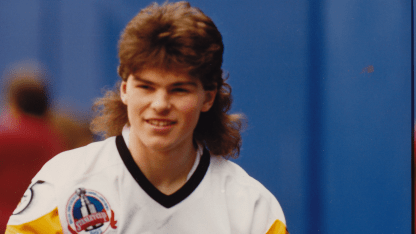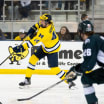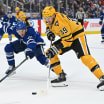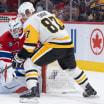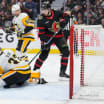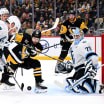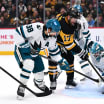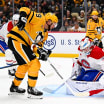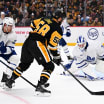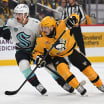There are some big parallels between Jaromir Jagr and Evgeni Malkin, two Penguins franchise superstars from different generations.
“I know when I came here, it looks like he's same as me,” Malkin said.
Both players had to leave their respective countries in veils of secrecy, arriving in Pittsburgh as teenagers without knowing the language or culture, relying on older veteran countrymen to be their mentors – Jagr with Jiri Hrdina, Malkin with Sergei Gonchar.
They each became half of a legendary duo – Jagr with Mario Lemieux, and Malkin with Sidney Crosby.
One of Jaromir’s nicknames during his time here, in addition to Jags, was actually ‘Geno.’
And finally, their larger-than-life personalities are a huge part of their legacies. Malkin’s humor and heart have come to define him, while Jagr’s magnetism, charisma, and, of course, that famous mullet won over the city of Pittsburgh before he even played a game.
Years before Malkin's arrival heralded the start of a 16-year playoff streak, Jagr helped create a buzz around a team that had yet to win a Stanley Cup and had made the postseason just once in the eight years before his arrival. Penguins fans knew they were likely getting a good player, with Jagr drafted fifth overall in 1990. They were delighted to discover that he also brought a youthful, unbridled enthusiasm for his new home.
“He wanted to enjoy Pittsburgh,” said Jagr’s teammate Bryan Trottier. “He wanted to get to know Pittsburgh.”
Jagr was born in 1972, a few years after the Warsaw Pact invasion of Czechoslovakia, which meant he grew up under Communist rule that ended in 1989, the year before his draft. Coming to America was a new sort of freedom that Jagr quickly embraced.
“He had to get acclimated, but once he did, he was like, wow – I like it here,” Bourque said. “I like the food here, I like the clothes here, I like the cars here, I like everything about this. This is a lot better than I thought it was going to be. And then you saw him just flourish off the ice and on the ice.”
Paul Steigerwald – Pittsburgh’s radio color analyst and a reporter for KDKA at the time – had the opportunity to spend time with Jagr off the ice. During one of his first days in Pittsburgh, Steigerwald took him shopping at the recently opened Ross Park Mall to see how he would react to the culture.
“I always heard that guys from Eastern Europe and Russian players, and players from behind the Iron Curtain had trouble getting nice blue jeans. So as soon as we went to the Gap, he gravitated right to the denim section, and he bought himself jeans and a blue jean jacket,” Steigerwald said. “He was trying them on, and that's what he wanted. He didn’t want anything else.”
Jagr soon ticked off another item on his shopping list: a hot rod. The number of speeding tickets he got driving a flashy sports car became legendary, as did the gifts he received from fans while amassing a cult following of sorts.
“He loved Kit Kats, and I remember Nestle’s, they just gave him boxes of Kit Kats because they heard it in an interview,” said Rick Tocchet, who won the Stanley Cup alongside Jagr in 1992.
In those days, fan mail got put into the players’ lockers, and along with the candy, there were letters and gifts from Jagr’s female fans. One of Tocchet’s favorite stories involves a birthday party for Jagr after Pittsburgh acquired the tough forward from Philadelphia.
“We had some guys who were married, so they didn’t go to it. I was single at the time, and I went,” Tocchet said. “I remember, I think it was a sports café – there must have been 900 people at his birthday party, and I think it was 875 girls. So, it was the impact of being an icon here. Even after the games, going on the bus, even visiting teams – there's always a crowd of people when Jags was around.”
Jagr loved laughing, loved joking around – but also won the respect of everyone around him, from his teammates and his coaches to the fans, for his dedication and commitment to hockey. “He wanted to be one of the best; he put in the time and effort,” his teammate Ron Francis said.
Tocchet remembers how morning skates are usually around 20-25 minutes, and some guys would stay out for a half hour. Not Jagr. He’d be out there for an hour, to the point where they had to kick him off the ice because he simply did not want to leave.
“The Pittsburgh fan base and the city, they love the athlete that works hard,” Tocchet said. “Obviously, they love the skill. But I think Jags coming in, the way he worked, one of the best corner guys ever seen coming out with the puck – I think that's why the fans loved him. I know he had the long hair, and the girls loved him. But his work ethic and just his elite skill together makes him a perfect hockey player.”
Mike Sullivan likes to say that nobody loves scoring goals more than Malkin, and that certainly applied to Jagr as well. Fans everywhere loved his iconic salute celebration, inspired by John Elway and the Denver Broncos. The Penguins even paid homage to it in the 2021-22 season when the team debuted the ‘Robo Pen’ jerseys made famous by Jagr and Lemieux.

